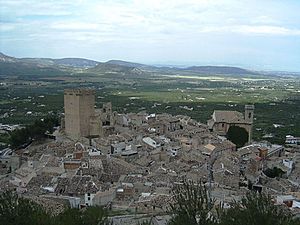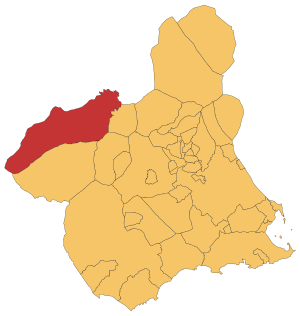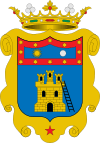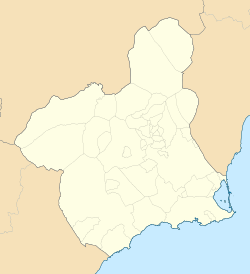Moratalla, Murcia facts for kids
Quick facts for kids
Moratalla
|
||
|---|---|---|
 |
||
|
||

Location in Murcia
|
||
| Country | ||
| Autonomous community | ||
| Province | ||
| Comarca | Noroeste | |
| Judicial district | Caravaca de la Cruz | |
| Area | ||
| • Total | 954.82 km2 (368.66 sq mi) | |
| Elevation | 681 m (2,234 ft) | |
| Population
(2018)
|
||
| • Total | 7,954 | |
| • Density | 8.3304/km2 (21.5755/sq mi) | |
| Demonym(s) | Moratalleros | |
| Time zone | UTC+1 (CET) | |
| • Summer (DST) | UTC+2 (CEST) | |
| Postal code |
30440
|
|
Moratalla is a small town in southeastern Spain. It is part of the Region of Murcia. Moratalla is also the name of a larger area, called a municipality.
In 2018, about 7,944 people lived in Moratalla. Most of them (around 5,600) lived in the main town. The rest lived in smaller areas like Otos, Benizar, El Sabinar, or Casa Requena.
The main ways people earn money here are through tourism and agriculture. Farmers grow crops like apricots, almonds, and olives. They also produce olive oil, wood, and barley.
Contents
Geography and Nature
Moratalla is a mostly mountainous area. It is cooler than other parts of the region. Snow often falls in the highest places, like Revolcadores, which is about 2,015 m or 6,611 ft tall. Cold valleys like Campo de San Juan and El Sabinar are also found here.
Small rivers, such as the Alhárabe and Benamor, flow through the area. These rivers eventually join the Segura River. There is a large water reservoir called El Cenajo on the Segura River.
Local Wildlife
You can find many interesting animals in Moratalla. Some common ones include wild boars and Spanish Ibex. Birds like short-toed eagles fly overhead. You might also spot Moorish turtles.
Large parts of Moratalla's nature are protected. These areas are called ZEPAs (Special Protection Areas) or LICs (Sites of Community Importance). This helps keep the local plants and animals safe.
History of Moratalla
People have lived in the Moratalla area for a very long time. We know this because of ancient cave paintings found here. These paintings show that people were present during Prehistory.
Later, during the Bronze Age, more people lived in this region. Some belonged to the Argaric culture in the late Bronze Age.
Medieval Times
After the Muslim invasion of Spain (from 711 to 726 AD), some Berber families settled in Moratalla.
In 1212, a group called the Order of Santiago took control of Moratalla. This happened during the Reconquista, a time when Christian kingdoms were taking back land in Spain. It was after a big battle called Las Navas de Tolosa.
Moratalla became its own separate town in 1245. This was after the Christian kingdom of Castile conquered the area of Murcia. Before this, Moratalla was part of a larger area called Segura de la Sierra.
Royal Connection
Francis, Duke of Cádiz was a king consort of Spain. He was married to Queen Isabella II. After he went to live in France in 1868, he used the special title of Count of Moratalla.
Population Changes
About 4.25% of the people living in Moratalla are from other countries. Most of these are from other parts of Europe or Africa. A smaller number are from the Americas and Asia.
The table below shows how the population of Moratalla has changed over time.
| Year | 1900 | 1910 | 1920 | 1930 | 1940 | 1950 | 1960 | 1970 | 1981 | 1991 | 2001 | 2011 |
|---|---|---|---|---|---|---|---|---|---|---|---|---|
| Population | 12,816 | 13,497 | 13,477 | 13,815 | 15,013 | 14,136 | 14,205 | 10,664 | 9,374 | 8,976 | 8,595 | 8,305 |
Economy and Jobs
In 2022, about 20% of the land in Moratalla was used for farming. The most common crops grown were almonds, barley, olives, oats, and lavender.
Most jobs in Moratalla are in the industrial sector, which means making things. About 55% of jobs were in this area in 2022. Farming and fishing jobs made up about 20%. Construction jobs were about 2.5%, and service jobs (like in shops or restaurants) were about 22%.
Places to See
Moratalla has many interesting old buildings and sights.
Historic Buildings
- Fortress Castle: This old castle is home to the "Tribute Tower" (Spanish: La Torre del Homenaje). It's a military-style building from the 15th century.
- Arab Castle in Benizar: This castle was built much earlier, in the 12th century.
- Church of Our Lady of the Asunción: This Catholic church (Spanish: Iglesia de Nuestra Señora de la Asunción) dates back to the 16th century.
- Other Churches: You can also find other old churches like Santa Ana and San Francisco.
- House of Christ: This building (Spanish: La Casa de Cristo) is located on a mountain. It was built by a religious group called the Order of La Merced in the 16th century.
Ancient Bridges
Moratalla has two old Roman bridges:
- The Jesus Christ Bridge crosses the Benámor River.
- The Hellin Bridge crosses the Alhárabe River.
Fun Events
Moratalla is known for its exciting festivals and events.
Holy Week Drumming Festival
During Holy Week, Moratalla has a special tradition called a tamborada. This is a huge drumming performance, also known as the Drummers Festival ("Fiestas del Tambor de Moratalla"). It can last all day long on Maundy Thursday, Good Friday, and Easter Sunday.
What makes Moratalla's drumming unique is that each tamborista (drummer) wears a special, handmade robe. Some also wear hoods. The drums are large and are also traditionally handmade. Drummers use special drumsticks shaped like mallets.
Holy Christ of the Thunder Festival
This festival, called "Fiestas del Santísimo Cristo del Rayo," is a lively celebration. It takes place in the streets of Moratalla. During this time, cows and bulls are let loose in the streets.
People gather in their peñas (groups or clubs) along Eldest Street ("Calle Mayor") to enjoy the party. There is also a fun fair that you can visit every night from July 10th to 17th. It's like an amusement park with many "street-shops" where you can buy handmade products.
Famous People
- Esteban Navarro (born in Moratalla, 1965): A well-known writer.
Images for kids
See also
 In Spanish: Moratalla para niños
In Spanish: Moratalla para niños








